INTRODUCING SPICE SOFTWARE IN ELECTRICAL ENGINEERING: IMPLICATION FOR DEVELOPING CIRCUIT DESIGN SKILLS
Keywords:
Simulation software, SPICE, circuit design skill, electronicAbstract
The present study examined the SPICE as a powerful open-source analog electronic circuit simulator that can enhance the circuit design skills of electrical engineering students in Edo State. The participants were 73 students enrolled in the electrical engineering department at the Edo State Polytechnic Usen, Edo State, Edo State. Their ages ranged from 19 to 30 years, with a mean age of 9.14 (M) and a standard deviation of 1.24 (SD). The participants were divided into two groups: Group A (Experimental Condition): Students who used SPICE simulation software in their coursework. Group B (Control Condition): Students who did not use SPICE and followed the traditional curriculum. A t-test analysis was conducted to address the research question: Would students in Edo State be better able to design circuits if they participated in a simulation program focused on integrated circuits? The results revealed a significant difference in circuit design skills between the experimental and control groups. Specifically, the experimental group demonstrated an average improvement of m=8.97 in their skills. The t-value was 6.212, indicating a strong effect. The p-value was .000, confirming statistical significance. In conclusion, the findings support using SPICE simulation software as an effective tool for enhancing circuit design skills among electrical engineering students. This study sheds light on the practical benefits of integrating SPICE into engineering education, emphasizing its role in bridging theory and practice.



